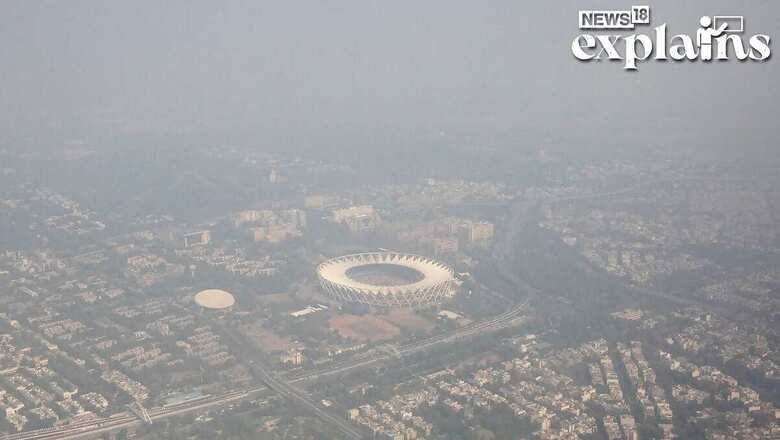
views
Amid worsening air quality, Delhi environment minister Gopal Rai this week said the government is planning to induce artificial rain through cloud seeding this month to combat the rising pollution levels. The air quality index in Delhi and the neighbouring areas remained in the ‘severe’ category at 421.
Rai held a meeting with scientists from IIT-Kanpur, who explained that cloud seeding can only be attempted when there are clouds or moisture in the atmosphere. “Experts anticipate that such conditions could develop around November 20-21. We have asked the scientists to prepare a proposal by Thursday (November 9) that will be submitted to the Supreme Court," he said.
The minister said obtaining the necessary clearances and permissions for using this technology from both the central and the state governments is a time-sensitive matter. The IIT-Kanpur scientists, who have conducted research on artificial rain, had delivered a presentation to the minister on September 12.
Air pollution has been a cause for concern in the national capital this month as the smoke from post-harvest paddy straw burning in neighbouring states like Punjab and Haryana has worsened the air quality. This has triggered a rise in respiratory problems among Delhi-NCR residents and put the vulnerable section in danger. Doctors have said breathing in Delhi’s polluted air is equivalent to the harmful effects of smoking approximately 10 cigarettes a day.

In order to combat the problem, the government has announced several measures, including the odd-even scheme, suspending in-person classes in all schools and Stage IV of the Graded Response Action Plan (GRAP). But, experts have warned that the conditions will get worse in the coming days due to Diwali.
Here is all about IIT-Kanpur’s method, which could bring temporary respite from the pollution in Delhi-NCR:
IIT Kanpur’s Potential Solution
IIT Kanpur is planning to create “artificial rain" to bring down pollutants and dust in Delhi to bring a temporary respite in the capital. IIT has been working for years researching on pollution and ways to tackle it. The institute since 2018 started working on a project to indue artificial rains.
In June this year, the institute successfully carried out a test to produce artificial rain through cloud seeding. It has obtained the required permissions from government authorities, including the Directorate General of Civil Aviation (DGCA) to deploy aircraft equipped with cloud-seeding devices.
During the trials this year, the IIT team got the DGCA approval to equip two Cessna aircraft with flare panels. Five trials were conducted, with four of them successfully inducing rain.
“Artificial rain through cloud seeding has been done before for drought relief in the country, but this will be the first time when an indigenously built cloud-seeding system will be used for pollution control," Manindra Agrawal, a professor in the institute’s computer science and engineering department told The National News.
Using the technology, the researchers believe they could wash away pollutants and dust with rains that would be artificially created. The IIT team is expected to use a six-seater Cessna plane to release salt from the flares into the clouds to stimulate and accelerate the condensation process that would eventually lead to rains.
The solution could offer a quick solution to the problem during days of severe pollution and provide temporary relief to the capital and its neighbouring areas.
“We have our own aircraft and over the last few years have installed an attachment on its wings, which is equipped with salt flares. We can take this aircraft below the clouds that will inject a certain mixture of salt into the clouds, which causes rain, provided the clouds have reasonable moisture," he reportedly added.
Delhi environment minister Gopal Rai in September said the government will explore ways to implement cloud seeding as part of its winter action plan to tackle air pollution.
How Artificial Rains Work?
Cloud seeding has been used for various reasons including lessening the impact of droughts, mitigating forest fires, increasing precipitation and improving air quality.
Cloud seeding is a process of weather modification to produce artificial rain where chemicals like silver iodide, potassium iodide and dry ice are sent to the atmosphere through aircraft and helicopters.
These particles attract the water vapour in the air, leading to the formation of cumulonimbus clouds and finally rain. It generally takes half-an-hour to produce rainfall by this method.
There are two ways to implement cloud seeding: firstly, is to seed supercooled clouds with silver iodide or dry ice, causing ice crystals to grow and consume moisture from the cloud to start rainfall and the second process involves warm clouds and hygroscopic materials like salt particles, which take on water vapor, becoming larger to fall faster.
Artificial Rain A Viable Solution?
An IIT Kanpur professor said that while artificial rain could offer better air quality for a temporary period, it’s not a long-term solution, according to a report in The Economic Times.
Moreover, cloud seeding is not only dependent on meteorological conditions or the DGCA, but also requires permissions from various authorities including the Ministry of Home Affairs and the Special Protection Group (SPG).
However, cloud seeding has harmful effects to the environment. The method can lead to acidification of the oceans, ozone layer depletion and an increase in the levels of atmospheric carbon dioxide. Silver is a heavy, toxic metal and it harms the health of plants, humans and animals.
The American Meteorological Society has acknowledged that though there is no evidence of downwind impacts of cloud seeding but the “activities conducted for the benefit of some may have an undesirable impact on others."
Silver iodide, the chemical commonly used to seed clouds, is known to be toxic and considered a hazardous substance.


















Comments
0 comment